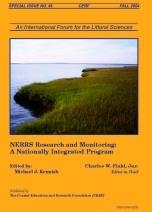The National Estuarine Research Reserve System (NERRS), consisting of a network of 26 protected estuarine reserves in the conterminous US, Alaska, and Puerto Rico, generates comprehensive research and monitoring databases in support of coastal resource-management programs. Integrated water-quality, nutrient, and biological monitoring protocols conducted by the NERRS program have been valuable for identifying and tracking short-term variability and long-term changes in the integrity and biodiversity of estuarine systems nationwide. Four areas of biological monitoring in the NERRS program form the foundation for detailed research initiatives; these include (1) submerged aquatic vegetation (SAV) and emergent vegetation (marsh plants), (2) benthos (benthic invertebrates and benthic algae), (3) plankton (specifically larvae), and (4) nekton (fish, decapod crustaceans, and other swimming animals). Watershed and land-use/land-cover characterizations, benthic habitat mapping, and benthic community surveys comprise other high-priority initiatives of the NERRS program. The articles in this volume provide results of both system-wide investigations and site-specific case studies of the NERRS research and monitoring initiatives.
BioOne.org will be down briefly for maintenance on 12 February 2025 between 18:00-21:00 Pacific Time US. We apologize for any inconvenience.
How to translate text using browser tools
1 November 2004
NERRS Research and Monitoring Initiatives
Michael J. Kennish
ACCESS THE FULL ARTICLE

Journal of Coastal Research
Vol. 2009 • No. 10045
Fall 2004
Vol. 2009 • No. 10045
Fall 2004
biomonitoring
land-use/land-cover characterizations
System-Wide Monitoring Program priority initiatives
Water-quality monitoring




